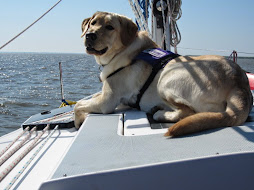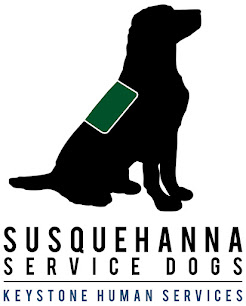We talk about our puppy raisers a lot, but they aren’t the
only ones who play an important role in shaping a young puppy into a successful
service dog. Our puppy sitters also help prepare the dogs for life as working service
dogs.
Puppy sitters are volunteers who take care of our dogs in
training when their puppy raisers are unable to do so. A dog may go to a sitter
while his raiser is on vacation or has a family emergency. Sometimes, our dogs
go to sitters just so they can gain exposure to new routines and experiences.
Once our dogs become working service dogs, they will go home
with their partner and have to adjust to a whole new daily routine. If you’ve
ever had to change up your own routine, you know that it can be a little
stressful at first, and it’s the same for dogs. However, we train our dogs to
adapt to new situations, and spending time at a sitter’s home, where they’ll
have a brand new routine, helps the dogs transition to their lives with their
new partners.
The dogs’ training doesn’t stop when they go to a sitter’s
home. Yesterday, we held one of our puppy sitter classes, where our sitters can
learn how to work with the dogs in public. Nine sitters joined us at Bass Pro
Shops in Harrisburg, PA, and each one was matched with a dog and a puppy
raiser. Together, they traversed Bass Pro and the Harrisburg Mall.
Since we only had one hour, we focused on six tasks and
behaviors: loose leash walking, getting in and out of the car, pottying,
greetings, leave it, and entering and exiting the elevator. All of our sitters
did a wonderful job working with their dog!
Loose Leash Walking
Loose leash walking is perhaps one of the most important and
most difficult behaviors to teach the dogs. The dog must walk on the left side
of the handler with the leash in a loose “J” shape. The handler clicks and
treats the dog for attention and for being in the correct position beside them.
The dog is never allowed to pull. If they pull, the handler
walks backward to give the dog “penalty yards” until the dog is in the correct
position again. Then they walk forward again, clicking and treating for a loose
leash.
Sometimes it can be very frustrating to work on loose leash
walking, especially if the dog is excited about being with a new person or in a
new place. But it’s so important to always reinforce the loose leash and never
let the dog pull. Once the dog is placed with their partner, pulling on the
leash could potentially injure their partner. The dog must have the self-control
to walk calmly next to their partner.
Car
Like loose leash walking, getting in and out of the car is
an exercise in self-control for the dogs. The dog must enter the car on the cue “car”
and wait to exit until given the “okay.” Why is this important? The safety of
the dog may depend on having the self-control to wait for the “okay” to exit
the car. The dogs will be going almost everywhere with their partners, which
means they’ll be getting in and out of the car a lot. So, for example, if they’re
getting out of the car at the grocery store, the dog must be able to wait for
their partner to make sure it’s safe for them to get out of the car in parking
lot.
Get Busy
All of our dogs potty on the cue “get busy.” (We don’t
recommend saying this cue inside, even if you’re not saying it as a cue for the
dog. Some of our dogs are very good at responding to these words!) Before they
enter any building or public space, our dogs must be given a chance to potty,
even if you know they’ve just gone half an hour ago. The Americans with
Disabilities Act (ADA) requires that all working service dogs be house trained,
and service dogs can be legally asked to leave if they are not house trained.
It just makes good sense to give the dog a chance to take care of business
before entering a public space.
Greetings
Service dogs must also be under control while out in public.
However, this can be very challenging for puppies in training, especially when
people want to pet the puppy. During greetings, the dog must have all four paws
on the floor, and their attention should be on their handler. It may help to
put the dog in a “sit” or a “down.” Feeding the dog treats (no clicks) while
someone is petting the dog will also keep the dog focused on their handler
instead of the person petting them.
In these situations, the handler can say no to people who
want to interact with the puppy. If they just need to take care of errands and
leave or if they don’t think the puppy can handle the greeting successfully, it’s
perfectly fine to tell people they cannot pet the dog.
Leave It
Our dogs should be able to ignore food or other items on the
floor. Even if a treat meant for the dog falls on the floor, the dog is not
allowed to eat it off the floor. They get a new treat (or two) from the treat
pouch.
Why is it important for the dogs to ignore food or other
items on the floor? For one, if the dog is chasing down food on the floor, it
means they’re not paying attention to their handler, which means the dog isn’t doing
their job. Two, the dog may pull to get to the food, which could potentially
harm their partner. Also, what the dog thinks is food might actually be harmful
to the dog. For example, if a person’s medication fell on the floor, the dog
must have the self-control to “leave it” until those meds can be picked up. So
the cue “leave it” means the dog must ignore the object and never gets to go
over and eat it.
“Leave it” can also be used to tell the dog to ignore people
or other animals.
Elevators
Many of our dogs will be riding in elevators with their
handlers, so it’s important for the dog and handler to be able to enter and
exit the elevator safely. You don’t want the doors to close with the dog on one
side and the handler on the other! The dog must wait while the handler blocks
the door with their body. Then the handler tells the dog to “go on through,”
which cues the dog to enter (or exit) the elevator, turn around, and look at their
handler.
Thank you to all of the sitters who joined us for class, and
thank you to the puppy raisers who shared their knowledge with our sitters!
If you’d like to sign up to become a puppy sitter for
Susquehanna Service Dogs, just visit our website and fill out an application.














No comments:
Post a Comment